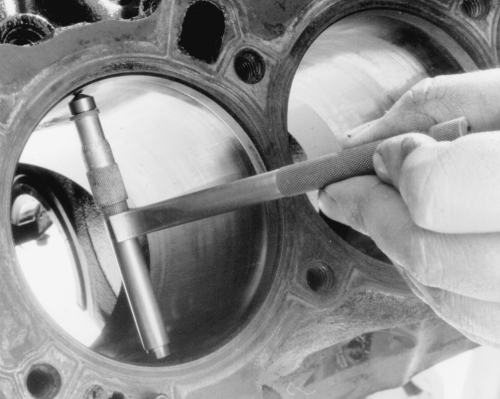In OilChat 33 bore polishing in diesel engines was discussed. Now the question is what is the difference between bore polishing and cylinder bore glazing? Early signs of both bore polishing and cylinder glazing are increased oil consumption (blue exhaust smoke) and loss of combustion pressure. Although the symptoms of the two phenomena are very much the same, their physical appearance and process of development are completely different.
Cylinder bore glazing (sometimes referred to as internal engine glazing or piling) is characterized by a very smooth, highly polished lacquer- or varnish-like layer on cylinder surfaces. If a glazed cylinder is examined, one will normally find the crosshatch grooves honed into the bore surface, are filled or covered by the glazing layer. (The purpose of the honing pattern is to retain oil to ensure proper lubrication and to form a seal between the piston rings and cylinder bore.)
Glazing in diesel engines is normally the result of prolonged light load, low-speed running and/or extended periods of idling. Typical examples are light trucks in local delivery service and small farm tractors hauling trailers in orchards during the harvesting season. Diesel engines are designed to operate at above 60% of their maximum rated load and ideally closer to 75%. Running an engine under low loads causes low cylinder pressures and consequent poor piston ring sealing since the rings rely on the cylinder pressure to force them against the oil film on the bores to form the seal. When cylinder rings are not sealing properly, hot combustion gases force their way past the rings and flash-bake the oil on the cylinder to form a hard deposit layer, commonly referred to as glazing. Once glazing has occurred, the honing marks in the bore are smoothed over, resulting in an even poorer seal between the piston rings and cylinder bore. The glazing issue becomes a vicious spiral allowing more and more hot combustion gases past the rings to bake further oil deposits on the cylinder.
Various remedies are suggested to cure bore glazing. Many of them involve introducing some sort of abrasive into the engine air inlet to abrade the glazing on the cylinder bores. Any abrasion, however, that occurs, will be along the axis of the cylinder (rather than the original crosshatch grooves), allowing more oil to pass the rings and thereby increasing oil consumption even further. If glazing is detected in its early stages (loss of power, increased oil consumption, and blue exhaust smoke), running the engine on a low-performance oil at maximum load may allow the piston rings to scrape the glazing off the cylinder bores. However, if glazing has been allowed to progress to an advanced stage, this procedure will not have any significant remedial effect. Advanced glazing can only be cured by stripping down the engine, re-boring the cylinders and machining new honing grooves.
Traditionally cylinder glazing was associated with the use of high-performance oils in lightly loaded diesel engines, but modern oil technologies have largely overcome the phenomenon of glazing. New
Q8 Formula Truck 7000 15W-40 is formulated with leading-edge additive chemistry to protect diesel engines against cylinder bore glazing.
To find out more about what Q8 Formula Truck 7000 15W-40 can do for your engines, please visit https://www.facebook.com/BlueChipLubricants/

